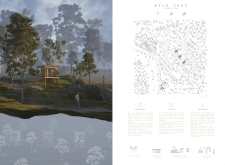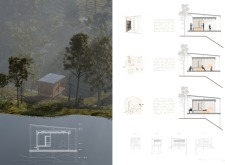5 key facts about this project
Located in a tranquil environment, the Wild Core Pods serve as unique accommodations that blend comfort with ecological consciousness. The architectural design focuses on enhancing the user experience while maintaining a low ecological footprint. The structure is elevated on slender pillars, which reduces site disturbance and allows for views of the surroundings, fostering a connection to nature.
Sustainable Material Usage
The project employs a range of carefully selected materials that support its sustainability goals. The predominant use of wood for the structural framework adds warmth and aligns with environmental considerations. Oriented Strand Board (OSB) is utilized for durability, while polyethylene aids in water conservation and insulation. Aluminium cladding is incorporated for protection against harsh weather, enhancing the building's longevity. Cork is also used for insulation, reinforcing the project's commitment to eco-friendly practices.
Adaptable Design Elements
The design features open interior spaces, allowing for a flexible layout that can accommodate various uses such as sleeping, working, or relaxing. Modular furniture and retractable elements provide the versatility needed for different living scenarios. The large openings create a seamless transition between indoor and outdoor environments, enhancing natural light and airflow.
Innovative Ecological Strategies
What distinguishes the Wild Core Sleeping Pods from conventional projects is its focus on minimizing environmental impact while promoting user connectivity to nature. The structure incorporates renewable energy sources, including photovoltaic panels, which support self-sufficient living. Water management systems are designed to collect and reuse resources efficiently, further underscoring the project's sustainable approach.
The elevating design allows for easy disassembly, showcasing a reversible aspect that enhances adaptability for future site development. The architectural framework not only respects the ecological integrity of the surrounding landscape but also encourages a lifestyle that harmonizes with nature.
For a more in-depth examination of the Wild Core Sleeping Pods project, including architectural plans, architectural sections, and architectural ideas, readers are encouraged to explore the detailed project presentation. This project serves as a notable example of how thoughtful design can address modern environmental challenges while offering unique living solutions.


























